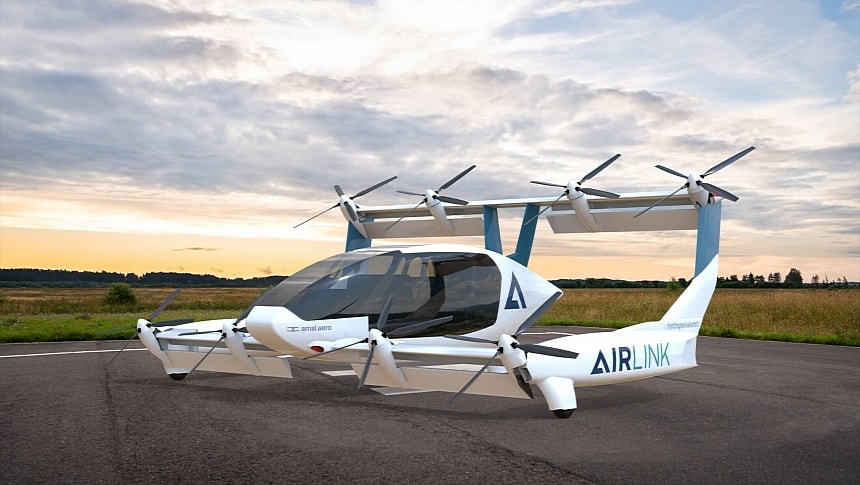New-generation VTOLs (vertical takeoff and landing), whether purely electric or hybrid-electric, are not just about fighting climate change by lowering emission levels; their efficiency has the potential to drastically reshape certain types of operations and services, including firefighting. In Australia, this goal is particularly important, and an Aussie-made aircraft will help tackle bushfires more effectively.
"A hi-tech flying bucket brigade" – this is how Mark York, the CEO of AMSL Aero, described the potential use of multiple autonomous aircraft to put out fires. These swarms of VTOLs could bring drastic benefits, from preventing the loss of human life to extending firefighting operations at night. Right now, Fire Service crews put their lives on the line with every mission and are forced to stop in conditions of low visibility and congested air space. Pilot-free VTOLs could improve both safety and efficiency.
To prove it, AMSL Aero, maker of the Vertiia hydrogen-powered VTOL, was awarded a grant by the Cooperative Research Centers. The Aussie startup will develop an autonomous version of its flagship aircraft with support from prestigious institutions, including the University of Sydney, Australian firefighting aviation operator Pay's Air Service, and robotics company Mission Systems.
The original version of the Vertiia aircraft brings the major advantages of a longer range and high capacity. According to its maker, it's able to carry hundreds of liters of water and effectively spray fire retardant while covering larger areas without having to recharge. An important note is that any kind of zero-emission firefighting aircraft comes with the long-term benefit of not worsening climate change, which is largely responsible for the increase in bushfire incidents.
Adding autonomous capabilities will enable ground operators to pilot the Vertiia aircraft remotely. This VTOL is not seen as a replacement for standard firefighting crew operations but as a strategic companion. It could help firefighters continue their efforts when it gets dark and when they need to reload. Another significant benefit is that lower costs associated with this type of aircraft will facilitate the deployment of swarms of VTOLs in multiple areas instead of a small number of aircraft.
In the near future, self-flying VTOLs could help reshape firefighting operations and support the environment at the same time. What better aircraft to pioneer this in Australia than an Aussie-designed and built model?
Vertiia combines battery technology with green hydrogen power, which makes it more sustainable than battery-electric VTOLs. It promises a 1,000 km (621 miles) range, coupled with a 300 kph (186 mph) speed and a maximum payload of up to 500 kg (1,100 lb), even claiming to be the world's most efficient zero-emission, long-range VTOL.
AMSL Aero was founded by husband and wife Andrew Moore and Siobhan Lyndon and is the first green aviation startup of its kind in Australia.
To prove it, AMSL Aero, maker of the Vertiia hydrogen-powered VTOL, was awarded a grant by the Cooperative Research Centers. The Aussie startup will develop an autonomous version of its flagship aircraft with support from prestigious institutions, including the University of Sydney, Australian firefighting aviation operator Pay's Air Service, and robotics company Mission Systems.
The original version of the Vertiia aircraft brings the major advantages of a longer range and high capacity. According to its maker, it's able to carry hundreds of liters of water and effectively spray fire retardant while covering larger areas without having to recharge. An important note is that any kind of zero-emission firefighting aircraft comes with the long-term benefit of not worsening climate change, which is largely responsible for the increase in bushfire incidents.
Adding autonomous capabilities will enable ground operators to pilot the Vertiia aircraft remotely. This VTOL is not seen as a replacement for standard firefighting crew operations but as a strategic companion. It could help firefighters continue their efforts when it gets dark and when they need to reload. Another significant benefit is that lower costs associated with this type of aircraft will facilitate the deployment of swarms of VTOLs in multiple areas instead of a small number of aircraft.
In the near future, self-flying VTOLs could help reshape firefighting operations and support the environment at the same time. What better aircraft to pioneer this in Australia than an Aussie-designed and built model?
Vertiia combines battery technology with green hydrogen power, which makes it more sustainable than battery-electric VTOLs. It promises a 1,000 km (621 miles) range, coupled with a 300 kph (186 mph) speed and a maximum payload of up to 500 kg (1,100 lb), even claiming to be the world's most efficient zero-emission, long-range VTOL.
AMSL Aero was founded by husband and wife Andrew Moore and Siobhan Lyndon and is the first green aviation startup of its kind in Australia.







